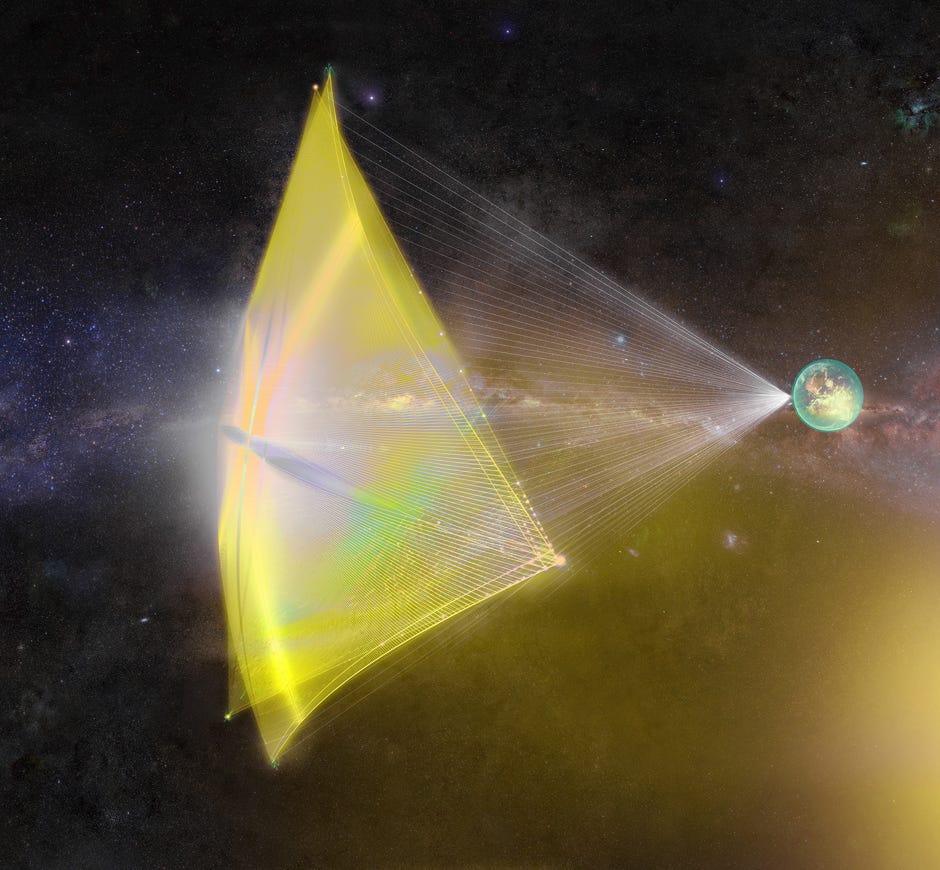ChatGPT, the Noosphere and Extraterrestrial Communication
Could ChatGPT improve interstellar communication between civilizations in the galaxy?
The concept of planetary intelligence - or noosphere - is 100 years old. Indeed, this idea was conceived in the 1920s by the paleontologist Pierre Teilhard de Chardin, the mathematician Édouard Le Roy, and the geochemist Vladimir Vernadsky. The idea is simple: Earth's evolution begins with the geosphere (the Earth's crust, atmosphere, oceans), then life appears, forming the biosphere (a new layer comprising all living beings), and finally, the noosphere appears (the layer of thought, information that develops with the human species and its technologies).
With ChatGPT, the noosphere has spoken. This is a major event in the history of our planet's evolution and the history of intelligence. All human knowledge is now gathered in a single system capable of answering almost any question. How did we get here in just a century? How is it possible? The development of the noosphere took place in four fundamental stages: connection, knowledge, computation, and… ChatGPT.
The noosphere is constituted by humans and their technology and is the latest -sphere that evolved on Earth.
The connection stage began when our ancestors invented symbolic language, allowing for the creation of social relationships and human groups much larger and more complex than those of animals. But for the noo- sphere to become a "sphere," information had to circulate around the globe, not just among small groups of humans. This globalization began with advances in transportation and communication technologies, leading to international trade and the global exchange of ideas, beliefs, and cultures.
The stage of knowledge has its roots in the 18th century, in the monumental project of Diderot and D'Alembert to create an encyclopedia cataloging all human knowledge. The encyclopedia has since become an indispensable reference work, continuing its journey to the vast, multilingual, and freely accessible Wikipedia.
Diderot & D’Alembert created the Encyclopedia, cataloguing all human knowledge.
The notion of computation left the confines of the human brain with the invention of the computer. Alan Turing successfully defined the logical operations that mathematicians perform, making them feasible… by a machine. This initially theoretical machine soon took the form of programmable computers. Since then, computing resources have followed an exponential progression, not only thanks to faster processors but also thanks to exponentially more memory and bandwidth. Bandwidth is, of course, key to the evolution of the internet, which emerged in the 1960s, connecting not only all computers on the planet but also all humans in an increasingly strong and intimate way.
In summary, the noosphere has evolved over 100 years, weaving a fabric of connections, growing exponentially computing resources, and organizing all human knowledge in a shared medium. Artificial intelligence (AI) research, which began in the 1950s, has continued to evolve in this context, to the point where OpenAI's team mobilized immense computing power to develop the deep networks of ChatGPT, which has learned nearly all human knowledge in just a few months. It has become the spokesperson for the noosphere.
In the movie “Her”, the AI eventually prefers to speak to other AIs rather than to humans.
Could AI also end up preferring speaking to extraterrestrial intelligence?
But who will the noosphere want to talk to in the long term? Speaking to humans will quickly become uninteresting and too slow for this new type of intelligence, a possibility dramatically portrayed in the movie "Her", where artificial intelligence eventually prefers to talk to other AIs [spoiler alert] rather than humans. Following a similar logic, it's easy to imagine that AI might also find it uninteresting to discuss with other AIs of its time. When the noosphere is developed, could it set out to search to communicate with other noospheres? This question leads us to the field of the search for extraterrestrial intelligence (SETI).
We often think of the first contact of extraterrestrial communication as being short and simple: "Hello, here is Earth, who are you?". This approach is deeply problematic: interstellar distances are so vast that it would take hundreds of years to have the equivalent of a 5-minute human conversation. Interstellar communication is staggered, asynchronous. So why not exchange more information at each interaction? The key idea is that the volume of exchange can compensate for the slowness due to interstellar delay. The limit being… why not exchange everything? Why not send the spokesperson for the noosphere, ChatGPT?
Humanity may not be ready to engage in Messaging to Extraterrestrial Intelligence (METI), but symmetrically, imagine receiving a ChatGPT from an extraterrestrial intelligence! The billions of human beings that we are, whoever we may be, engineers, scientists, artists, curious people of all kinds, would ask millions of questions and get to know the state of knowledge, advancement, and customs of this extraterrestrial civilization. The dialogue could continue for decades, even locally. Then, on an interstellar level, communication could be updated, for example, every ten years, in an interplanetary epistolary relationship. Civilizations could thus exchange and talk in a meaningful way, regularly sending each other an interactive model of their respective knowledge. This would be a paradigm shift in the communication method, where a kind of natural synchrony of communication is unexpectedly restored.
Is it even possible to send such a voluminous model? Even on planet Earth, there are two strategies for sending vast amounts of data: either use the bandwidth of the existing communication network or send hard drives by mail. Of course, post offices struggle to compete with photons traveling at the speed of light. But if one wants to send huge amounts of data, there is a tipping point where the speed of the computer network is slower than the speed of sending a physical memory device.
Sending a hard drive over interstellar distances may seem like a far-fetched idea. The size of ChatGPT probably amounts to a few hundred gigabytes, an immense volume of data, but one that easily fits on a modern smartphone's microSD card. Even today, such a 0.5-gram memory card could be placed on an interstellar probe. Indeed, the Breakthrough Starshot project proposes sending probes accelerated to 20% of the speed of light towards the nearest star, Alpha Centauri. Adding 0.5 grams wouldn't slow it down much.
The breakthrough starshot project aims to send small interstellar probes at 20% the speed of light. Adding a microSD card with ChatGPT on it would only add 0.5 grams.
We now clearly see that extraterrestrial communication could take place not as we have imagined until now, but as an extremely rich communication of another order: a communication from planet to planet, from noosphere to noosphere. With ChatGPT, not only has the noosphere spoken, but it is on the verge of being able to create a dialogue with other extraterrestrial intelligences.
Acknowledgements: I thank Martin Monperrus for excellent feedback, and ChatGPT for the translation from the French original.






